![]()
![]()
![]()
Use LEFT and RIGHT arrow keys to navigate between flashcards;
Use UP and DOWN arrow keys to flip the card;
H to show hint;
A reads text to speech;
111 Cards in this Set
- Front
- Back
|
Function of the neurological system |
Responsible to drive the other body systems |
|
|
Central Nervous System |
•Brain and spinal cord |
|
|
Peripheral Nervous System |
•Cranial nerves and the spinal nerves •Afferent pathways: ascending •Efferent pathways: descending •Somatic nervous system •Autonomic nervous system •Sympathetic autonomic nervous system (SANS) •Parasympathetic autonomic nervous system (PANS) |
|
|
Overview of Nervous System |
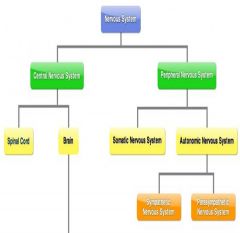
|
|
|
Cells of the Nervous System |
•Neurons •Primary cells of the nervous system •Structures differ according to their specialized function •Uses glucose for energy, but does not require insulin •Supporting cells •Neuroglial cells (CNS) •Schwann cells(PNS) |
|
|
Structure of the Neuron |
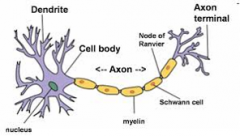
•Cell bodies •Usually located in CNS •If in PNS, itis called ganglia or plexuses •Dendrites -Carry impulses toward the cell body •Axons-Carry impulses away from the cell body •May have myelin sheath to speed impulse movement •Small interruptions called nodes of Ranvier where •Axons can branch •Nutrient exchange occurs |
|
|
Nerve Conduction |
•Speed of conduction is determined by •Condition of the myelin sheath (MS) •Diameter of the axon (larger is faster) |
|
|
Three types of Neurons |
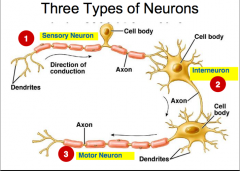
1. Sensory •Afferent,towards the CNS 2. Associational(interneuron) •Neuron to neuron; sensory to motor •Only in theCNS 3. Motor •Efferent, away from the CNS |
|
|
Nerve Injury and Regeneration |
•Mature neuron cells do not divide •Injury can cause permanent loss of function: spinal cord injury (CNS) •Some regeneration can occur in myelinated fibers of the PNS •If cut, motor axon can regrow to its distal connection •This occurs only if the Schwann cells remain intact to form a guiding tunnel and that path remains open •Scar tissue can block this process •Injuries close to the cell body have a poor chance of regeneration •Crush injuries have a greater chance of regeneration than a cut •Cuts heal via scar/connective tissue that can block regeneration |
|
|
Nerve Impulse |
•Electrical and chemical impulses generated by the neurons •Unexcited: at resting membrane potential •Excited: membranepotential is raised, generating an action potential resulting in the nerve impulse flowing through neuron •This excitation must be sufficient to cause an action potential •If not, no signal is sent via the neuron •“all or none response” |
|
|
Nerve Impulse Generation at the Cellular Level consists of |
Repolarization and Depolarization |
|
|
Depolarization(excitation) |
•Membrane is more permeable to Na+ and more moves into the cell •Membrane potential decreases to zero •Cell is more positively charged and its polarity is neutralized |
|
|
Repolarization |
•K+permeability increases (leaves the cell) while Na permeability decreases(remains in cell) •Membrane returns to the Resting Potential •2 K+ inside with 3 Na+ outside |
|
|
Nerve Impulse from Cell to Cell |
•Neurons are separated from each other by synapses •Impulses are transmitted across the synapse by chemical or electrical conduction •Presynaptic: sends impulse towards the synapse •Postsynaptic: sends impulse away from the synapse |
|
|
Chemical Conduction at the Synapse |
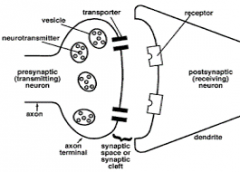
•As impulse reaches the presynaptic area •Vesicles are present •Contain neurotransmitters •Neurotransmitters are released •Diffuse across the synaptic cleft •Neurotransmitters bind to the sites on the postsynaptic cleft •Relay begins again |
|
|
Neurotransmitters |
"MOVE IN ONE DIRECTION" •More than 30 are known, but most common are: •Acetylcholine(E/I) •Norepinephrine(E/I) •Serotonin (I) •Dopamine (E) •Histamine (E for H1 and H2, I for H3) •GABA (I inpostsynaptic brain) •Glycine (I inpostsynaptic spinal cord) •Glutamate andaspartate (E) •Endorphins andenkephalins (I) •Substance P(E) |
|
|
Postsynaptic nerve is excited |
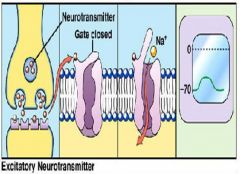
•Depolarization occurs •Excitatory postsynaptic potential (EPSP) •If this is great enough, the nerve impulse is propagated forward |
|
|
Post synapticnerve is inhibited |
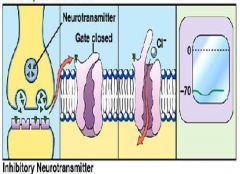
•Hyperpolarization occurs •Inhibitory postsynaptic potentials (IPSP) •The nerve impulse stops here |
|
|
Central Nervous System Gray matter vs White Matter |
Gray matter: cell bodies and dendrites White matter: myelinated nerve fibers |
|
|
Brain (CNS) |
•Cerebrum •cerebral cortex, limbic system and basal ganglia •Diencephalon •thalamus and hypothalamus •Brainstem •midbrain, pons and medulla •Cerebellum •two lateral hemispheres •Reticular Activating System •Connects brainstem to cerebrum |
|
|
Spinal Cord (CNS) |
•Extension of the central nervous system •Encased in spinal column, ending at ~L1-L2 •LP taps are done below this level •L3-4 or L4-5 |
|
|
Cerebrum: Cerebral Cortex, Limbic System and Basal Ganglia |
•Higher mental functions •General movement •Visceral functions •Perception •Behavior •Integration of functions •Communicates with the spinal cord via Brainstem •Controls many involuntary functions •Right hemisphere controls the left side of the body •Left hemisphere controls the right side of the body •Cerebral cortex is gray matter (cell bodies) |
|
|
Four Lobes of the Cerebrum |
Frontal Lobe Temporal Lobe Parietal Lobe Occipital Lobe |
|
|
Frontal lobe |
•Voluntary skeletal movement •Fine repetitive movement •Control of eye movement |
|
|
Parietal lobe |
•Interpretation of tactile sensations •Recognition of body parts •Awareness of body position •Proprioception |
|
|
Occipital lobe |
•Interpretation of visual data (inputfrom retina) |
|
|
Temporal lobe |
•Perception and interpretation of sounds, taste, smell •Interpretation of speech (Wernicke area •Balance |
|
|
Assessing Cerebral Function |

|
|
|
Cerebrum: Basal Ganglia |
•Major cerebral nuclei (gray matter) •Important connections with other portions of the brain •Stabilizing effect on motor movements •Coordinating movements •Parkinson/Huntington |
|
|
Cerebrum: Limbic System |
•Mediate emotion through connections in the prefrontal cortex |
|
|
Diencephalon: Thalamus(right and left) |
•Processes sensory input •Passes the messages along to the cerebral cortex |
|
|
Diencephalon: Hypothalamus |
•Responsible for homeostasis •Temperature •Heart rate •Blood pressure •Effects the endocrine system •Controls emotional behavior •Acts on the pituitary via hormone release |
|
|
Brainstem |
•The cranial nerves emerge from the brainstem •Controls many involuntary functions |
|
|
Three components of Brainstem |
•Midbrain(mesencephalon) •Pons •Medulla Oblongata |
|
|
Midbrain |
•Motor nuclei of the trochlear and oculomotor nerves |
|
|
Medulla Oblongata |
•Most caudal portion of the brainstem •Continuous with the spinal cord •Crossover of the spinal tracts occurs at this level •Damage above this level: opposite side (R hemisphere affects L body) •Damage below this level is ipsilateral (R hemisphereaffects R body) |
|
|
Reticular Activating System |
Brainstem Connection to Cerebrum •Several neuronal circuits that connect brainstem to the cortex •Responsible for regulating wakefulness and sleep-wake transitions •How can the nurse assess? •Controls vital reflexes •Cardiovascular function •Respirations •How can the nurse assess? |
|
|
Cerebellum |
•Responsible for coordination of muscles •Consists of gray and white matter •Aids the motor cortex of the cerebrum in influencing muscle tone and coordinating muscle action •Assessment •Movement is smooth •Tone is normal •Not flaccid or spastic •Maintenance of body equilibrium |
|
|
Spinal Cord |
•Begins at the foramen magnum and is a continuation of the medulla oblongata •Connects brain to body •A rope like structure of white and gray matter *Gray matter: cell bodies and dendrites White matter: myelinated nerve fibers |
|
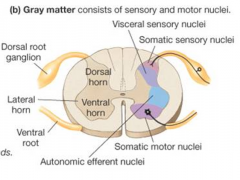
|
•A ropelike structure of white andgray matter •Gray matter (Cell bodies) •Arranged in a butterfly shape: •Anterior horn/ventral root •Efferent-motor •Posterior horn/dorsal root •Afferent-sensory •White matter (Myelinated fibers) •Forms the ascending and descendingspinal tracts |
|
|
Ascending spinal tract |
carry sensory information to the brain. Afferent pathway dorsal horn/DP |
|
|
Descending spinal tract |
carry commands toward motor neurons efferent pathway Ventral root/horn |
|
|
Reflex Arcs |
•Reflex arcs •Respond to stimuli and provides protection via motor movement •Movement occurs before the brain perceives the stimuli •Has four components •Receptor •Receives the stimuli •Afferent sensory neuron •Eventually get the information to the cerebral or cerebellar cortex •Efferent motor neuron •Relay information from cerebrum to brain stem/spinal cord •Effector muscle (or gland) |
|
|
Upper Motor Neurons |
•Completely in the CNS •Conveying impulses for voluntary motor movement •Influences spinal reflex arc •Forms synapses to connect with lower motor neurons •Destruction results in initial paralysis followed by partial recovery |
|
|
Lower Motor Neurons |
•Project into the periphery •Directly influences muscles •Destruction leads to paralysis but the peripheral nerve may possibly regenerate. |
|
|
Cerebral Palsy vs Progressive MuscularAtrophy |
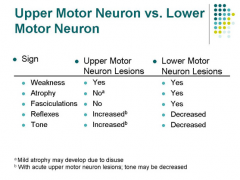
|
|
|
Meninges |
•Protective structure that surrounds the brain and spinal cord •Made of three protective membranes •Dura mater •Arachnoid space •Pia mater |
|
|
Dura mater |
•Rigid membrane that supports and separates brain structures |
|
|
Arachnoid space |
•Spongy, weblike structure |
|
|
Pia mater |
•Delicate membrane that attaches to brain/spinal cord and provides support for blood vessels |
|
|
Epidural Space |
•Between the skull and dura mater •Injury:epidural hematoma |
|
|
Subdural space |
•Between dura and arachnoid •Injury: subdural hematoma |
|
|
CSF and the Ventricular System |
•Cerebrospinal Fluid •Clear,colorless and similar to blood plasma •Protects the brain and spinal cord from injurious blows •600 ml is produced daily within the ventricles •125-150 ml is circulating in ventricles and subarachnoid spaces •Formed from the blood and after use is returned to the blood •Villi in the arachnoid space act as a one-way valve to move CSF in to the blood •Pressure is twice as high in an upright position |
|
|
Nerve Damage from Disc Herniation |
•Intervertebral discs cushion between the vertebra •Nucleus pulposus is in the center of the disc •Too much stress and wear and tear causes herniation •Disc contents rupture •Pressure to the spinal nerves (chemical also) •Level is easily detected by symptoms •L4/L5 sciatica pain |
|
|
Brain Blood Supply |
•20% of cardiac output (~1 L/min) •Internal carotids •Vertebral arteries •Circle of Willis provides collateral blood flow (5 major arteries) •Venous drainage has impact on ICP •Jugular vein occlusion causes IICP |
|
|
Blood Supply to Spinal Cord |
•From vertebral arteries and regions of the aorta •Anterior and posterior spinal arteries branch and form plexuses •Penetrate the spinal cord •Venous drains into venous sinuses between the dura and periosteum |
|
|
Peripheral Nervous System (PNS) |
•Carries information to and from the CNS •12 Cranial nerves •31 Peripheral nerves •Controls somatic and autonomic nervous system |
|
|
Somatic Nervous System |
Regulates muscle movement & response to pain/touch |
|
|
Autonomic Nervous System |
•Sympathetic Autonomic Nervous System (SANS) •“fight orflight” •Parasympathetic Autonomic Nervous System (PANS) •Conserves energy during relaxation and rest |
|
|
Peripheral Nervous System |
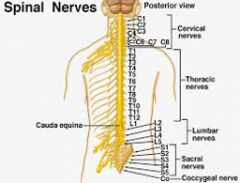
•31 symmetrically arranged pairs of spinal nerves •Contain both sensory and motor neurons •C1 through C8 (8) •T1 through T12 (12) •L1 through L5 (5) •S1 through S5 (5) •One coccygeal (1) |
|
|
Cranial Nerves (12 pairs PNS) |
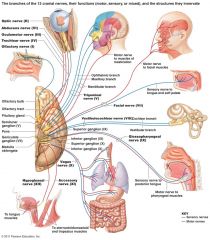
•I: olfactory •II: optic •III, IV &VI: oculomotor, trochlear, abducens •V: trigeminal •VII: facial •VIII: vestibuloacochlear •IX: glossophayyngeal •X: superiorganglion (vagus) •XI: accessory •XII:hypoglossal |
|
|
Assessment of Cranial Nerves |
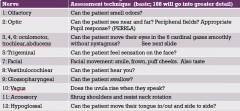
|
|
|
Testing Extraocular Motion: CN III, IV & VI |
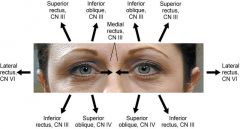
|
|
|
Dermatomes of the Spinal Nerves |
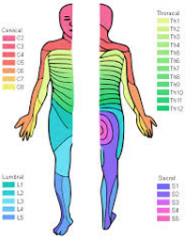
•Band of skin innervated by the sensory root of a single spinal nerve(afferent) •Posterior Horn(dorsal root) •Help to determine the location of an injury •Nursing Assessment •Light/deep touch •Sharp/dull |
|
|
Autonomic Nervous System (ANS) |
•Components of ANS are distributed all over the body •Coordinates and maintains a steady state •Cardiac muscle •Smooth muscle •Glands •Involuntary system (as opposed to the somatic nervous system) •Composed of two parts •Sympathetic nervous system (SANS) •Parasympathetic nervous system (PANS) |
|
|
SANS |
•“Fight orFlight” •Mobilizes energy in times of need •Neuronal impulses stimulate the adrenal medulla •Rapid release of epinephrine and norepinephrine •SANS actions are protective and widespread throughout the body •^ glucose, ^temperature, ^ BP •Most important function is regulation of vasomotor tone] |
|
|
PANS |
•Conserves andrestores energy •Nerves travelclose to the organs they innervate •Those thatarise from the brainstem travel to the head, thorax, and abdomen within thecranial nerves •III oculomotor •VII facial •IX glossopharyngeal •X vagus •PANS promotesrest and tranquility and NOT widespread •Decreased HR,increased visceral functions> |
|
|
The vagus nerve - X |
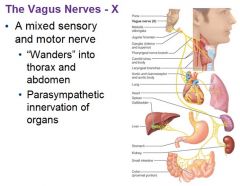
|
|
|
Cholinergictransmission |
•occurs withacetylcholine •SANSpreganglionic and a few postganglionic (sweat glands) •PANS pre andpost ganglionic |
|
|
Adrenergictransmission |
•occurs withnorepinephrine (adrenalin) •SANSpostganglionic •Alphareceptors •Alpha 1adrenergic is mostly excitation or stimulation •Alpha 2adrenergic is associated with relaxation •Beta receptors •Beta 1adrenergic increases HR and contractility and causes renin release •Beta 2adrenergic |
|
|
SANS and PANS |
•SANS and PANScan cause an opposite response when an organ is innervated by both •Stomach •SANS:decreased peristalsis •PANS:increased peristalsis |
|
|
Clinical Application of PANS/SANS |
•Blood PressureRegulation •Occurs viaperipheral vascular resistance (PVR) •SANS increasesPVR •PANS maintains anormal level—doesn’t really decrease it •To lower BP, the treatmentmust control SANS response(reduce it) •Control viathe beta receptors in theperipheral circulation •Beta blockers for BP control •Propranolol •Timolol •Labetalol |
|
|
Neurological Age Considerations: Older Adults |
•Number ofcerebral neurons decreases •Slower thoughtprocesses •Reducedresponse to stimuli •Delayedreflexes •Decreasedability to attend to multiple tasks •Velocity ofnerve impulse conduction declines •Slowedresponse time •Diminishedtouch and pain perception •Decreasedproprioception •Increased unsteadiness, or decreased agility •Interference with performance of ADLs |
|
|
Neurological Age Considerations: Older Adults Cont. |
•Transientneurologic deficits •May indicate transient ischemic attacks (TIAs)•Hearing loss,vision deficit, anosmia •May contribute to social withdrawal •Change incognitive function variable(memory) •Genetics, disuse •Interferencewith performance of ADLs •Functional assessment, gait assessment |
|
|
Neuroanatomy of Pain (all sensory) |
•Sensation andperception of pain •Afferentpathway (cause of pain) •Sensed via PNSand travels via the dorsal horn to the brain •Interpretivecenters (pain interpreted) •Located inbrain stem, midbrain, diencephalon and cerebral cortex •Efferentpathway (brain sends action) •Sensationreturns to the ventral horn of the spinal cord |
|
|
Nociception |
•Transmissionof pain •Noxiousstimuli are processed via a normally functioning nervous system •Contains 4 stages: transduction, transmission, perception, and modulation |
|
|
Pain Transduction |
•Noxiousstimuli is perceived via the nociceptor; not equally distributed on body |
|
|
Pain Transmission |
•Pain sensationconducted along dorsal horn and ascends to the thalamus (relay station) |
|
|
Pain Perception |
•Awareness ofpain, usually via reticular and limbic systems and cerebral cortex |
|
|
Pain Modulation |
•Mechanismsthat decrease or increase pain transmission through the nervous system |
|
|
Neuromodulation of Pain |
•Neuromodulatorscan be triggered in many ways •Tissueinjury releases prostaglandins andbradykinins •Chronicinflammation releases lymphokines |
|
|
Excitatory neuromodulators |
•causeincreased sensitivity to pain or a lowerpain threshold •Repeatedexcitatory stimulation can cause pathologic changes in CNS resulting inincreased sensitivity to future pain in that areas |
|
|
Inhibitory neuromodulators |
•inhibitcentral sensitivity to pain or raise the pain threshold •More stimulusis needed for pain to be sensed (think of pain meds) •GABA, glycine,serotonin, norepinephrine, and endogenous opioids •Whatare some common pain medications? Morphine, dilaudid,codeine, norco, vicodan |
|
|
Endogenous Opioids |
•Family ofmorphine-like substances that block pain impulses in the spinal cord, brain andperiphery •Binds withopioid receptors mu, kappa, and delta •Inhibits therelease of excitatory neurotransmitters •Naturalopioids are produced by the body (endogenous) •Endorphins •The body canalso raise the pain threshold during stress, excessive physical exertion,acupuncture, sexual intercourse •The mom whocan lift a heavy object off of her child •Manufacturedopioids are introduced into the body (exogenous) •Codeine andothers on previous slide |
|
|
Clinical Picture of Pain- Acute Pain |
•protectivemechanism causing immediate action •Seconds todays, up to 3 months (^HR,^BP, diaphoresis, pupil dilation) •Somatic pain:superficial, from the skin •Visceral pain:from internal organs, associated with N/V •Referred pain:pain felt in an area distant from point of origin |
|
|
Clinical Picture of Pain- Chronic/persistent pain |
•Lasting longerthan “normal” for that area/injury (>3mos) •Serves nobeneficial purpose; dysregulation of nociception and pain modulation |
|
|
Clinical Picture of Pain-Neuropathic pain |
•dysfunction inthe nervous system •Peripheral:nerve entrapment or diabetic neuropathy •Central:complex regional pain syndrome |
|
|
Referred Pain Chart |
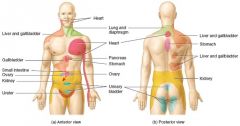
|
|
|
Pain Threshold |
•Lowestintensity of pain that is perceived •With multiplepain sources, the most severe is experienced the greatest •Perceptualdominance •When dominantpain disappears, others are more noticeable •Post-oppatient with Rheumatoid Arthritis |
|
|
Pain Tolarence |
•Greatestintensity of pain that can be endured •Variable amongand within people •Decrease paintolerance with •Fatigue, sleepdeprivation •Repeatedexposure to pain •Anger,apprehension, boredom •Increase paintolerance •Alcohol,opioid medication •Hypnosis,distraction •Strong beliefsor faith |
|
|
Temperature Regulation |
•Homeostasis:96.2 to 99.4 F (36.2 to 37.7 C) •Raising thetemperature via chemical thermogenesis is a complex process •Hypothalamus-TSH-RH-->Anterior Pituitary-TSH-->Thyroid-Thyroxine-->Adrenal Medulla--Epinephrine--> |
|
|
Epinephrine |
causes: •Vasoconstriction •Stimulatesglycolysis •Increasesmetabolic rate |
|
|
Involuntaryprocess for heat conservation |
•Hypothalamus -->stimulates SANS-->stimulates the adrenal cortex-->vasoconstriction--> shunting blood away from periphery to the core. *Voluntary action: bundle up, put on clothes |
|
|
Temp Regulation Infants |
•Full termproduces heat via brown fat •Cannotconserve heat •Small bodysize •Greater bodysurface •Inability toshiver •Poorinsulation with subcutaneous fat •Preemiescannot produce heat |
|
|
Temp Regulation Elderly |
•Poor responseto temperature extremes •Slowed bloodcirculation •Structural/functionalskin changes •Decreasedheat-producing abilities •Slowedmetabolic rate •Poor abilityto sweat •Decreasedvasoconstrictor response |
|
|
Pathogenesis of Fever |
•“Set point” ofthe hypothalamus is reset to a higher level •Thermoregulatorycenter allows heat production and adjusts conservation and heat loss tomaintain increased temperature •Follows aprocess •Pathogensproduce exogenous pyrogens/endotoxins •Endotoxinsstimulate release of endogenous pyrogens from phagocytic cells •Endogenouspyrogens induce hypothalamus to reset the temperature higher •Patient feelscold •Dresses warmlyand tries to maintain heat while also conserving heat (fatigue) •Whenendogenous pyrogens stop production, “fever breaks” and the hypothalamus goesback to normal set point |
|
|
Benefits of Fever |
•Elevated temperature helps respond to infectiousprocesses 1.Kills and/oradversely affects replication of microorganisms 2.Decreasesserum levels of Fe, Zinc, Copper (bacterial growth) 3.Lysosomalbreakdown and auto-destruction of cells 4.Facilitatesimmune system by increasing lymphocyte transformation and motility ofneutrophils 5.Enhancesphagocytosis |
|
|
Hyperthermia |
•Increase inbody temperature without an increase in the hypothalamic set point •Therapeutic • facilitatingthe host’s natural immune process (local/systemic) •Accidental •Heat cramps,heat exhaustion, heat stroke, and malignant hyperthermia •Associatedwith stroke or head trauma •Increases ICPproduces temp > 102.2 F (39 C) •Noninfectiouscentral fever without sweating (resistant) •Highertemperatures can be damaging •105.8 F (41C): nerve damage can produce convulsions •109.4 F (43C): death results from coagulation of proteins |
|
|
Hypothermia |
•Marked coolingof the core temperature (<95 F / 35 C) •Therapeutic:during surgery, after arrest, after neurologic injury •Accidental:immersion in cold water, prolonged exposure, altered thermoregulatory mechanism •Coolingproduces depression of the CNS and Respiratory (ischemic tissue damage) •Vasoconstriction •Changes inmicrocirculation and coagulation •Severehypothermia •Ice crystalsform on the inside of the cell and they rupture |
|
|
Sleep |
•Providestissue restoration/promotes memory consolidation •Timing iscontrolled by hypothalamus (circadian rhythm) •Two phases ofsleep via EEG: REM and non-REM |
|
|
REM |
•is 20-25% •Occurs aboutevery 90 minutes after 1-2 hours asleep in non-REM •EEG resemblesawake; brain is very active with dreaming •Increased PANSactivity with variable SANS activity: rapid eye movement, increased cerebralblood flow, erections •Many memorabledreamstpp |
|
|
Non-REM |
•is 75 to 80% •SANS decreasesand PANS increases: state of reduced activity •Drop in basalmetabolic rate 10-15% with temperature decrease along with heart, RR, BP andmuscle tone |
|
|
Sleep Disorders: Dyssomnias Insomnia |
•Inability tofall or stay asleep •Chronic/transient,due to time zone travel, acute stress, chronic pain/depression, alcohol abuse |
|
|
Sleep Disorders: Dyssomnias ObstructiveSleep Apnea Syndrome |
•Upper airwayobstruction>>snoring and apneic episodes •Awakens self,disrupts sleep causing REM deprivation •Hypercapniaoccurs with low oxygen saturation •Leads topolycythemia, pulmonary hypertension and R-sided CHF, systemic hypertension,liver congestion, cyanosis |
|
|
Sleep Disorders: Dyssomnias Hypersomnia |
•excessivedaytime sleeping •Associatedwith OSAS •Treat the OSASand it improves |
|
|
Sleep Disorders: Dyssomnias Narcolepsy |
•excessivedaytime sleepiness with REM •Centralorigin: hallucinations, sleep paralysis, cataplexy •Hypothalamicdisorder (genetic component) •Treatment •Medications,but not 100% effective (Provigil, Nuvigil) •Well-timednaps and safety precautions |
|
|
Sleep Disorders: Dyssomnias Disorder of sleep/wake cycle |
•> 3 hrs of jet lag,rotating shifts •Desynchronizescircadian rhythm •Decreasevigilance and arousal •Poorperformance of psychomotor skills |
|
|
Sleep Disorders: Parasomnias |
Involveunusual behavior while sleeping |
|
|
Sleep Disorders: Parasomnias Somnambulism (sleepwalking) |
•CNSimmaturity? Common in young and resolves •Not associatedwith dreaming |
|
|
Sleep Disorders: Parasomnias Night terrors |
•CNSimmaturity? •Periods ofarousal with intense fear and emotion, but not awake •Difficult toarouse, but once awoken, has no memory of incident |
|
|
Sleep Disorders: Parasomnias Restless legSyndrome (RLS) |
•Sensorimotordisorder with unpleasant sensations when at rest •Associatedwith a circadian fluctuation of dopamine (familial tendency) •Urge to movethe leg for relief—disrupts sleep •More common inwomen, elderly and iron deficiency •Iron is neededfor dopamine production |

